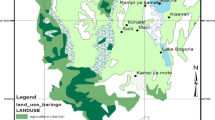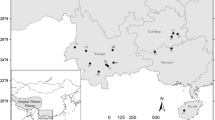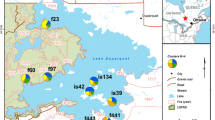Abstract
Euptelea pleiospermum is an “old rare” tree species distributed along the high-elevation streamsides in Burma, China, and India. Deforestation and construction of roads for timber transport have highly fragmented the natural habitats of this species in the Shennongjia Forestry District. In this study, we used this fragmentation to test the hypothesis that “old rare” tree species are insusceptible to the genetic consequences of habitat fragmentation. Using eight microsatellite loci, we estimated allelic richness (A R), observed heterozygosity (H O), expected heterozygosity (H E), Wright’s inbreeding coefficient (F IS), and genetic differentiation (F ST and D EST) between pre- and post-fragmentation cohorts. We found no significant differences in either genetic diversity or genetic differentiation between the two cohorts. The limited genetic effects of fragmentation may result from too few fragmented generations, because the time between the start of fragmentation (year 1970) and our study (year 2008) was less than one generation of this tree species. It should be mentioned that clonal reproduction by sprouting, a common phenomenon in many “old rare” tree species, can help E. pleiospermum buffer the genetic impacts of fragmentation by delaying the time between generations. Therefore, we conclude that this “old rare” tree species show limited genetic impacts from recent habitat fragmentation. However, the elimination of rare alleles and increase of inbreeding coefficient in the post-fragmentation cohort are early warnings of deleterious genetic consequences of fragmentation. Our results provide valuable information to formulate conservation and restoration guidelines for E. pleiospermum.

Similar content being viewed by others
References
Aguilar R, Quesada M, Ashworth L, Herrerias-Diego Y, Lobo J (2008) Genetic consequences of habitat fragmentation in plant populations: susceptible signals in plant traits and methodological approaches. Mol Ecol 17:5177–5188
Aldrich PR, Hamrick JL, Chavarriaga P, Kochert G (1998) Microsatellite analysis of demographic genetic structure in fragmentation populations of the tropical tree Symphonia globulifera. Mol Ecol 7:933–944
André T, Lemes MR, Grogan J, Gribel R (2008) Post-logging loss of genetic diversity in a mahogany (Swietenia macrophylla King, Meliaceae) population in Brazilian Amazonia. For Ecol Manag 255:340–345
Andrianoelina O, Favreau B, Ramamonjisoa L, Bouvet JM (2009) Small effect of fragmentation on the genetic diversity of Dalbergia monticola, an endangered tree species of the eastern forest Madagascar, detected by chloroplast and nuclear microsatellites. Ann Bot 104:1231–1242
Bacles CFE, Jump AS (2011) Taking a tree’s perspective on forest fragmentation genetics. Trends Plant Sci 16:13–18
Bartholomew B, Boufford DE, Chang AL, Cheng Z, Dudley TR, He SA, Jin YX, Li QY, Luteyn JL, Spongberg SA, Sun SC, Tang YC, Wan JX, Ying TS (1983) The 1980 Sino-American botanical expedition to western Hubei Province, People’s Republic of China. J Arnold Arbor 64:1–103
Booy G, Hendriks RJJ, Smulders MJM, Van Groenendael JM, Vosman B (2000) Genetic diversity and the survival of populations. Plant Biol 2:379–395
Collevatti RG, Grattapaglia D, Hay JD (2001) Population genetic structure of the endangered tropical tree species Caryocar brasiliense, based on variability at microsatellite loci. Mol Ecol 10:349–356
Cornuet JM, Luikart G (1996) Description and power analysis of two tests for detecting recent population bottlenecks from allele frequency data. Genetics 144:2001–2014
Crawford NG (2010) SMOGD: software for the measurement of genetic diversity. Mol Ecol Resour 10:556–557
Dayanandan S, Dole J, Bawa K, Kesseli R (1999) Population structure delineated with microsatellite markers in fragmented populations of a tropical tree, Carapa guianensis (Meliaceae). Mol Ecol 8:1585–1592
Di Rienzo A, Peterson AC, Garza JC, Valdes AM, Slatkin M, Freimer NB (1994) Mutational processes of simple-sequence repeat loci in human populations. Proc Natl Acad Sci USA 91:3166–3170
DiBattista JD (2008) Patterns of genetic variation in anthropogenically impacted populations. Conserv Genet 9:141–156
Doyle JJ, Doyle JL (1987) A rapid DNA isolation procedure for small quantities of fresh leaf tissue. Phytochem Bull 19:11–15
Excoffier L, Laval G, Schneider S (2005) Arlequin ver. 3.0: an integrated software package for population genetics data analysis. Evol Bioinform Online 1:47–50
Farwig N, Braun C, Böhning-Gaese K (2008) Human disturbance reduces genetic diversity of an endangered tropical tree, Prunus africana (Rosaceae). Conserv Genet 9:317–326
Fernández-M JF, Sork VL (2007) Genetic variation in fragmented forest stands of the Andean oak Quercus humboldtii Bonpl. (Fagaceae). Biotropica 39:72–78
Fu LK, Jin JM (1992) China plant red data book: rare and endangered plants. Science Press, Beijing, pp 680–681
Goudet J (2001) FSTAT, a program to estimate and test gene diversities and fixation indices (version 2.9.3). Updated from Goudet (1995). http://www.unil.ch/izea/softwares/fstat.html
Honnay O, Jacquemyn H (2007) Susceptibility of common and rare plant species to the genetic consequences of habitat fragmentation. Conserv Biol 21:823–831
Jost L (2008) GST and its relatives do not measure differentiation. Mol Ecol 17:4015–4026
Jump AS, Peñuelas J (2006) Genetic effects of chronic habitat fragmentation in a wind-pollinated tree. Proc Natl Acad Sci USA 103:8096–8100
Kamm U, Gugerli F, Rotach P, Edwards P, Holderegger R (2011) Genetic consequences of low local tree densities—implications for the management to naturally rare, insect pollinated species in temperate forests. For Ecol Manag 262:1047–1053
Kang M, Jiang M, Huang H (2005) Genetic diversity in fragmented populations of Berchemiella wilsonii var. pubipetiolata (Rhamnaceae). Ann Bot 95:1145–1151
Kettle CJ, Hollingsworth M, Jaffré T, Moran B, Ennos RA (2007) Identifying the early genetic consequences of habitat degradation in a highly threatened tropical conifer, Araucaria nemorosa Laubenfels. Mol Ecol 16:3581–3591
Kramer AT, Ison JL, Ashley MV, Howe HF (2008) The paradox of forest fragmentation genetics. Conserv Biol 22:878–885
Lande R (1988) Genetics and demography in biological conservation. Science 241:1455–1460
López-Pujo J, Zhang FM, Ge S (2006) Plant biodiversity in China: richly varied, endangered, and in need of conservation. Biodivers Conserv 15:3983–4026
López-Pujo J, Zhang FM, Sun HQ, Ying TS, Ge S (2011) Centres of plant endemism in China: places for survival or for speciation? J Biogeogr 38:1267–1280
Lowe AJ, Boshier D, Ward M, Bacles CFE, Navarro C (2005) Genetic resource impacts of habitat loss and degradation; reconciling empirical evidence and prediction theory of Neotropical trees. Heredity 95:255–273
Mathiasen P, Rovere AE, Premoli AC (2007) Genetic structure and early effects of inbreeding in fragmented temperate forests of a self-incompatible tree Embothrium coccineum. Conserv Biol 21(1):232–240
Moreira PA, Fernandes GW, Collevatti RG (2009) Fragmentation and spatial genetic structure in Tabebuia ochracea (Bignoniaceae) a seasonally dry Neotropical tree. For Ecol Manag 258:2690–2695
Myers N, Mittermeier RA, Mittermeier CG, da Fonseca GAB, Kent J (2000) Biodiversity hotspots for conservation priorities. Nature 403:853–858
O’Connell LM, Mosseler A, Rajora OP (2006) Impacts of forest fragmentation on the mating system and genetic diversity of white spruce (Picea glauca) at the landscape level. Heredity 97:418–426
Ouborg NJ, Pertoldi C, Loeschcke V, Bijlsma RK, Hedrick PW (2010) Conservation genetics in transition to conservation genomics. Trends Genet 26:177–187
Pan KY, Lu AM, Wen J (1991) Chromosome number and development of gametophytes in Euptelea pleiospermum (Eupteleaceae). Acta Phytotaxon Sin 29:439–444
Parker M, Mac Nally R (2002) Habitat loss and the habitat fragmentation threshold: an experimental evaluation of impacts on richness and total abundances using grassland invertebrates. Biol Conserv 105:217–229
Peakall R, Smouse PE (2006) GENALEX 6: genetic analysis in Excel. Population genetic software for teaching and research. Mol Ecol Notes 6:288–295
Peterson A, Bartish IV, Peterson J (2008) Effects of population size on genetic diversity, fitness and pollinator community composition in fragmented populations of Anthericum liliago L. Plant Ecol 198:101–110
Piry S, Luikart G, Cornuet JM (1999) BOTTLENECK: a computer program for detecting recent reductions in the effective population size using allele frequency data. J Hered 90:502–503
Rasmussen KK, Kollmann J (2004) Poor sexual reproduction on the distribution limit of the rare tree Sorbus torminalis. Acta Oecol 25:211–218
Reed DH, Frankham R (2003) Correlation between fitness and genetic diversity. Conserv Biol 17:230–237
Rice WR (1989) Analyzing tables of statistical tests. Evolution 43:223–225
Šmídová A, Münzbergová Z, Plačková I (2011) Genetic diversity of a relict plant species, Ligularia sibirica (L.) Cass. (Asteraceae). Flora 206:151–157
Sokal RR, Rohlf FJ (2000) Biometry: the principles and practice of statistics in biological research, 3rd edn. Freeman and Company, New York
Tang CQ, Ohsawa M (2002) Tertiary relic deciduous forests on a humid subtropical mountain, Mt. Emei, Sichuan, China. Folia Geobot 37:93–106
Torres-Díaz C, Ruiz E, Gonzalez F, Fuentes G, Cavieres LA (2007) Genetic diversity in Nothofagus alessandrii (Fagaceae), an endangered endemic tree species of the coastal maulino forest of central Chile. Ann Bot 100:75–82
Wang J, Kang M, Gao P, Huang H (2010) Contemporary pollen flow and mating patterns of a subtropical canopy tree Eurycorymbus cavaleriei in a fragmented agricultural landscape. For Ecol Manag 260:2180–2188
Wei X, Jiang M (2012) Contrasting relationships between species diversity and genetic diversity in natural and disturbed forest tree communities. New Phytol 193:779–786
Wei XZ, Huang HD, Jiang MX, Yang JY (2008) Quantitative characteristics and spatial distribution patterns of Euptelea pleiospermum populations in riparian zones of the Shennongjia area, central China. Chin J Plant Ecol 32:825–837
Wei XZ, Jiang MX, Huang HD, Yang JY, Yu J (2010a) Relationships between environment and mountain riparian plant communities associated with two rare tertiary-relict tree species, Euptelea pleiospermum (Eupteleaceae) and Cercidiphyllum japonicum (Cercidiphyllaceae). Flora 205:841–852
Wei XZ, Liao JX, Jiang MX (2010b) Effects of pericarp, storage conditions, seed weight, substrate moisture content, light, GA3 and KNO3 on germination of Euptelea pleiospermum. Seed Sci Technol 38:1–13
Weir B, Cockerham C (1984) Estimating F-statistics for the analysis of population structure. Evolution 38:1358–1370
White GM, Boshier DH, Powell W (2002) Increased pollen flow counteracts fragmentation in a tropical dry forest: an example from Swietenia humilis Zuccarini. Proc Natl Acad Sci USA 99:2038–2042
Yao X, Ye Q, Kang M, Huang H (2007) Microsatellite analysis reveals interpopulation differentiation and gene flow in the endangered tree Changiostyrax dolichocarpa (Styracaceae) with fragmented distribution in central China. New Phytol 176:472–480
Yao X, Zhang J, Ye Q, Huang H (2011) Fine-scale spatial genetic structure and gene flow in a small, fragmented population of Sinojackia rehderiana (Styracaceae), an endangered tree species endemic to China. Plant Biol 13:401–410
Ying TS, Chen WL, Zhang ZB, Zhu ZQ, Yang JY, Wang FS, Hu ZL, Meng ZB, Sun X (1999) Study on the impact of human alteration on ecosystem diversity in Shennongjia area. In: Chen LZ, Wang WZ (eds) the impact of human alteration on ecosystem diversity. Zhejiang Science and Technology Publishing House, Hangzhou, pp 139–199
Young A, Boyle T, Brown T (1996) The population genetic consequences of habitat fragmentation for plants. Trends Ecol Evol 11:413–418
Zhang P, Shao G, Zhao G, Le Master DC, Parker GR, Dunning JB, Li Q (2000) China’s forest policy for the 21st century. Science 288:2135–2136
Zhang J, Yao X, Wei X, Chen L, Jiang M (2008) Development and characterization of 14 polymorphic microsatellite loci in the endangered tree Euptelea pleiospermum (Eupteleaceae). Mol Ecol Resour 8:314–316
Acknowledgments
We thank Dong He and Qiang Li for their assistance in sampling and lab work. We are also grateful to Dr. Scott B. Franklin for helpful comments. We appreciate two anonymous reviewers for their valuable comments and suggestions. This work was supported by grants from the National Natural Science Foundation of China (Nos. 31070465 and 31100344).
Author information
Authors and Affiliations
Corresponding author
Rights and permissions
About this article
Cite this article
Wei, X., Jiang, M. Limited genetic impacts of habitat fragmentation in an “old rare” relict tree, Euptelea pleiospermum (Eupteleaceae). Plant Ecol 213, 909–917 (2012). https://doi.org/10.1007/s11258-012-0052-2
Received:
Accepted:
Published:
Issue Date:
DOI: https://doi.org/10.1007/s11258-012-0052-2




